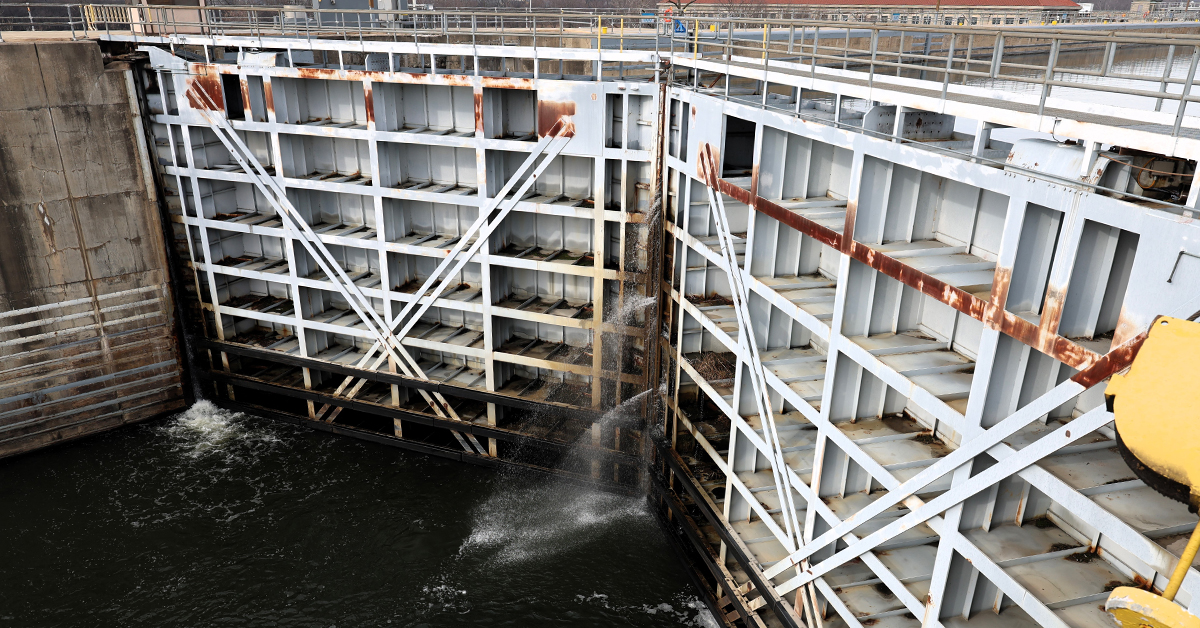The Corps of Engineers is investigating how best to obtain components to repair the lower miter gates at Lockport Lock and Dam as the navigational lock remains closed due to cracked pintle castings and bushings.
The lock at Illinois River Mile 291 closed for scheduled repairs on January 28 and was originally scheduled to reopen March 28. Instead, inspectors found cracks February 19 and 21 so severe that the gates cannot be operated safely, according to Mike Walsh, chief of the Waterways Project Office for the Chicago Engineer District. An initial assessment indicated the lock will need to remain closed until temporary repairs are completed between April 30 and May 6, with a second closure of four to six weeks later this year. There is no auxiliary lock at Lockport Lock and Dam.
“The team is doing a lot of great work,” Walsh said. “They’re looking at every available option. They’re doing an incredible amount of research and engineering to try to find the quickest solution that buys us enough time so we can get open as quickly as we can while we work to procure those permanent parts.”
Walsh said on a videoconference call with industry on February 28 that the Corps is simultaneously investigating two repair plans, one of which could potentially avoid the need for a heavy-lift crane and jacking the gates, shaving a week or two off the anticipated closure. An engineering team was due to visit the site March 3-4 to collect more information to see if that would be feasible. He did not want to give additional details until that determination had been made.
Terry Bass, president of the Illinois River Carriers’ Association, said that he had spoken to Corps representatives later in the week, and he expected another call to update industry during the week of March 10.
Bernie Heroff, chairman of the River Industry Action Committee, asked why the cracks weren’t immediately noticed when the lock chamber was dewatered. Walsh said an inspection team was scheduled far in advance, and those completing the work left additional time in the schedule for the dewatering in case of delays due to weather or water conditions, so they were not on site for some time after the chamber had been dewatered.
Walsh said the Corps has determined that lead times for replacement parts needed to complete gate repairs are “at least 60 days out.” The Corps is investigating the feasibility of casting, forging and 3D printing components.
“There are a lot of hypotheticals here and a lot of unknowns that still remain,” he said.
One bright spot is that the Corps has been successful in obtaining funding for temporary repairs and likely for the permanent replacement parts, Walsh said.
Walsh asked those on the call if industry would prefer for the Corps to extend the current closure and move forward with the permanent repair, rather than having a second closure later.
Mike Blaske, general manager of Ilinois Marine Towing, based in Joliet, Ill., said he personally would prefer an option to open as quickly as possible to take care of customers’ needs in the Lockport pool, then plan an additional closure later.
Mike Nappo, commercial manager of CITGO Petroleum, agreed, saying it was already difficult to manage resources until a potential late April or early May lock reopening.
“We’re trying to form up our response plan,” he said. “The river is pretty important to us.”
Walsh also asked those on the call what major freight movements were being impacted by the closure, which has cut off the Chicago area from the Mississippi River.
Chemicals, petroleum and aggregates were all mentioned, along with liquids, steel, cement and raw materials for many different industries in Indiana. Those on the call also brought up concerns that customers who change their transportation mode for products are unlikely to come back to the river for future transportation needs.
“We are looking at every potential engineering plan we can to get this thing back on track,” Walsh said.
Darren Melvin, marine operations manager at Heidelberg Materials Midwest, said it would be optimal if any additional closures could take place at the same time as other planned closures along the Illinois Waterway.
Walsh said, while the Corps would try to align closures with those at other facilities as much as possible, it might not be doable.
“The sooner we can get the permanent repairs in the better,” Walsh said. “That’s going to be largely dependent on when we can get the funding to do that second closure, which is going to require another dewatering. That’s going to require a significant amount of money.”
When pressed on an estimate for a potential second closure for the permanent repair, Walsh said he thinks the Corps likely would target the fall season, but he added that easily could change as the Corps determines how to proceed with repairs and what the lead time for parts might be.
The Corps plans to monitor the lock gates closely until those permanent repairs are made, he said, adding that discussion was taking place about instrumentation that could potentially replace the necessity for divers to go down regularly. Submersible cameras were one option, he said.
————
Featured image caption: A view of a pair of miter gates at Lockport Lock and Dam late last year, ahead of its ongoing closure for maintenance and emergency repairs. (Photo courtesy of the Chicago Engineer District)




